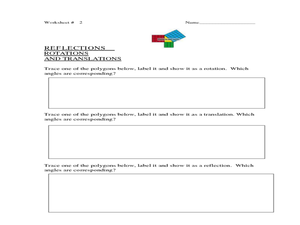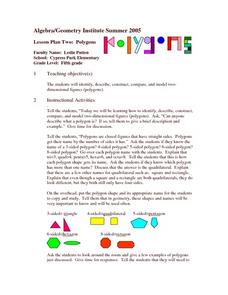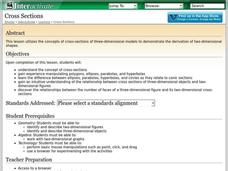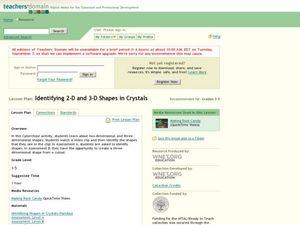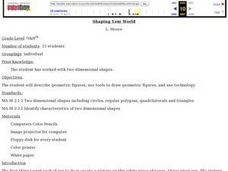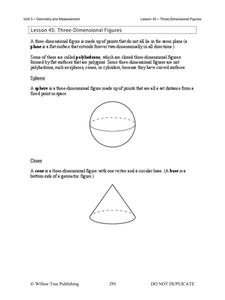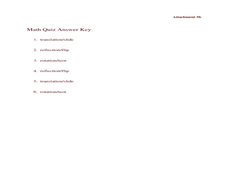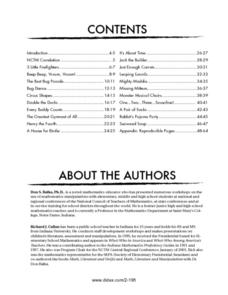Curated OER
Point Comparisons
Young geometers investigate two-dimensional figures using coordinate grids. They identify polygons and draw examples of their reflection, rotation, and translation on a coordinate grid. And they complete a worksheet practicing examples...
Curated OER
Views of Shapes
In this math activity, middle schoolers examine the two and three dimensional shapes. They use the observations in order to define the different points of view.
Curated OER
Eye-Popping Op Art
Students examine and discuss work of Hungarian artist Victor Vasarely, recognize visual components of Op Art, compare traditional Renaissance perspective with Op Art's illusion of three-dimensional space, and create original painting...
Curated OER
Countdown Challenge: Platonic Solids - Part II
In this platonic solid learning exercise, learners observe five solids and draw a net of each three-dimensional figure. Students examine a tetrahedron, an octahedron, an icosahedron, a cube, and a dodecahedron. This is a one-page...
Curated OER
Edible Geometry
Students examine a chart that lists the main characteristics of polygons and 3 dimensional figures. They make examples of the polygons and figures using pretzels and gum drops showing how the gum drops are vertices and the pretzels are...
Curated OER
The Very Hungry Caterpillar - Teaching Shapes
Learners identify two- and three-dimensional figures and associate them with real-world objects. In this geometry lesson, students are read The Very Hungry Caterpillar by Eric Carle and complete several activities including a chart of...
Curated OER
Shapes Galore!
First graders create two-dimensional shapes. In this shapes lesson, 1st graders learn about different two-dimensional shapes. Students have many hands-on experiences with these shapes including the use of geoboards, shaving cream, yarn,...
Curated OER
Lesson Plan Two: Polygons
Learners explore the concept of polygons on a two-dimensional plane. They identify polygons in everyday life and draw different polygons according to their classification. Using a geoboard and geobands, they consrtuct polygons and even...
Curated OER
Classifying Three-Dimensional Shapes
Compare geometric solids based on their properties. Your emergent geometers use spaghetti and marshmallows to build models so they can examine the number of faces, edges, and vertices on polyhedra of their own creation. Resource includes...
Shodor Education Foundation
Cross Sections
Use this activity on cross-sections of three-dimensional shapes in your math class to work on algebra or geometry Common Core standards. The lesson includes a list of relevent terminology, and a step-by-step process to illustrate the...
Curated OER
"Polly"gon Pockets
Explore polygons with your elementary learners. Divide the class in 12 to configure the polygon puzzle before them. They list the attributes of each type of polygon they see, and if there's time, they jump on the interactive website...
Utah Education Network (UEN)
Insides and Outsides
Give small groups handfuls of unit cubes and then dare them to build as many rectangular prisms as possible using only 12 cubes. This engaging activity serves as an introduction to the volume of solid figures. In addition to volume,...
Curated OER
Identifying 2-D and 3-D Shapes in Crystals
Students view a video on making rock candy and identify the shapes they see while watching. In this 2 and 3 dimensional shape lesson, students recognize shapes and complete worksheets to identify them. Students build a cube. Students...
Curated OER
Identifying Three Dimensional Figures (3)
In this 3 dimensional figures worksheet, students study the 10 3-dimensional figures. Students identify and label each of the 10 figures.
Curated OER
Shaping Your World
Pupils describe geometric figures. They create pictures and list each shape they used to create their pictures. They discuss the importance of shapes in their lives and create ten different geometric shapes using the Drawing tools in...
Willow Tree
Three-Dimensional Figures
Time to move into the third dimension! Learn the names of the geometric solids and count faces, edges, and vertices. Then learn to recognize nets that create a given solid.
Mathematics Vision Project
Module 5: Modeling with Geometry
Solids come in many shapes and sizes. Using geometry, scholars create two-dimensional cross-sections of various three-dimensional objects. They develop the lesson further by finding the volume of solids. The module then shifts to finding...
Curated OER
Sorting 2-Dimensional Shapes
Some shapes have square corners, and some do not. Scholars participate in a sorting activity as they determine if these 12 shapes have square corners, categorizing them based on this attribute. Encourage geometers to draw the square into...
Radford University
2 and 3 Dimensional Shapes
Take a similar approach to three dimensions. Pupils develop the relationship between areas of similar objects and see how they relate to the ratio of the sides. Building upon area formulas, small groups put together volume formulas for...
Curated OER
Square Corners
What type of corners does this shape have? Young geometers examine 12 shapes, circling the square corners in each if they have any. There are two examples demonstrating this concept, but be sure scholars understand the difference between...
Teach Engineering
Seeing All Sides: Orthographic Drawing
How can your draw three-dimensional figures on paper? The lesson shows pupils how to draw orthographic projections of three-dimensional figures composed of cubes. After viewing a PowerPoint presentation, they practice this skill with...
Curated OER
Fun With Transformations
Demonstrate and discuss the three types of transformations: rotation, reflection, and translation. Participate in a game which helps to reinforce and practice what they learned. Groups work collaboratively to complete the game.
Illustrative Mathematics
Grandfather Tang's Story
It's amazing the complex figures that can be made using only a few simple shapes. Following a class reading of the children's book Grandfather Tang's Story by Ann Tompert, young mathematicians use sets of tangrams to create models of the...
Curated OER
Math-Literature Connection: Counting with Jack the Builder
Connect literature (Jack the Builder) with mathematical concepts. In a series of computation, geometry and number sense activities, pupils count on to add, count back to subtract, build cylinders, cones, and rectangular prisms, and name...
Other popular searches
- Two Dimensional Figures
- Two Dimensional Figures
- 2 Dimensional Figures Change
- 2 Dimensional Figures Lessons


